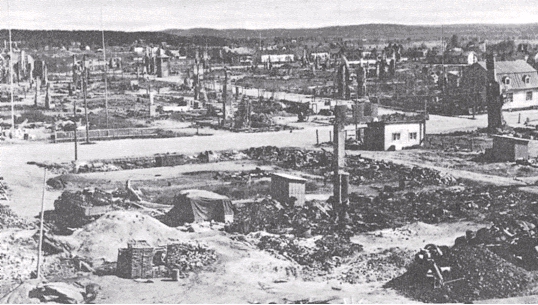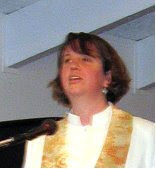 Friday afternoon it was time for our Reindeer Safari at the Sirmakko Family Reindeer Farm. These are REAL reindeer herders, not just people making a euro off the tourists (though they are doing that, too). The family has been in the Reindeer business for at least 5 generations. They are Sami people (indigenous Laplanders) and our guide said he has shaman blood in him.
Friday afternoon it was time for our Reindeer Safari at the Sirmakko Family Reindeer Farm. These are REAL reindeer herders, not just people making a euro off the tourists (though they are doing that, too). The family has been in the Reindeer business for at least 5 generations. They are Sami people (indigenous Laplanders) and our guide said he has shaman blood in him. Our visit started in the "kota." The Sirmakko kota is sided in wood but a traditional one would be sided with reindeer hides, much like a Native American tepee. The Sami were nomadic people who followed their reindeer and lived in these kotas year-round as recently as 50 years ago.
Our visit started in the "kota." The Sirmakko kota is sided in wood but a traditional one would be sided with reindeer hides, much like a Native American tepee. The Sami were nomadic people who followed their reindeer and lived in these kotas year-round as recently as 50 years ago.  Our guide did a short drumming ceremony to ask the gods permission to do the ceremony welcoming us across the arctic circle. There is no stress or hurry north of the arctic circle, our guide said. "Sometimes I have many things to do in a short time, but I never hurry," he said. I love that. I think that if you hurry you are more likely to make mistakes, and mistakes in the arctic can be deadly. Better to be focused and clear and leave stress and hurry behind.
Our guide did a short drumming ceremony to ask the gods permission to do the ceremony welcoming us across the arctic circle. There is no stress or hurry north of the arctic circle, our guide said. "Sometimes I have many things to do in a short time, but I never hurry," he said. I love that. I think that if you hurry you are more likely to make mistakes, and mistakes in the arctic can be deadly. Better to be focused and clear and leave stress and hurry behind. Logs in the fire place are all laid in one direction, other wise your reindeer will get lost. (Also, our guide told us on the side, traditionally the fire would be on the floor, not raised up like this one, and the family would all be living right around it, even little kids. Logs laid across one another have a tendency to shift and roll when they burn down and might roll into the living area, but logs laid straight are more stable and safer. I love hearing the daily reality behind the stories.)
Logs in the fire place are all laid in one direction, other wise your reindeer will get lost. (Also, our guide told us on the side, traditionally the fire would be on the floor, not raised up like this one, and the family would all be living right around it, even little kids. Logs laid across one another have a tendency to shift and roll when they burn down and might roll into the living area, but logs laid straight are more stable and safer. I love hearing the daily reality behind the stories.) 
 Legend has it that anyone who has once visited the Lapland will return again ... in their next life ... as reindeer! But only if you receive the spots where your antlers will grow (otherwise you will come back as an elephant in Africa). We all got our spots and left them on for the required three hours.
Legend has it that anyone who has once visited the Lapland will return again ... in their next life ... as reindeer! But only if you receive the spots where your antlers will grow (otherwise you will come back as an elephant in Africa). We all got our spots and left them on for the required three hours.
 Kalee is practicing being a reindeer.
Kalee is practicing being a reindeer. After the ceremony it was a colorful traditional (vegetarian) Sami dinner of mashed potatoes (white), beets (purple), and rice and carrots (orange) with tomatoes, bread, pickles, and preserved lingonberries on the side. Our guide's grandmother picked and preserved the berries. They were a bit sweet but also vinegary. Not usually what I would choose but quite good.
After the ceremony it was a colorful traditional (vegetarian) Sami dinner of mashed potatoes (white), beets (purple), and rice and carrots (orange) with tomatoes, bread, pickles, and preserved lingonberries on the side. Our guide's grandmother picked and preserved the berries. They were a bit sweet but also vinegary. Not usually what I would choose but quite good.
 Kalee's best cranky face. How can a girl be that cranky while drinking hot chocolate? Such determination.
Kalee's best cranky face. How can a girl be that cranky while drinking hot chocolate? Such determination. Finally the sun is setting and it is time for our sleigh ride. First we meet the reindeer that will pull us. We stay well away from the antlers.
Finally the sun is setting and it is time for our sleigh ride. First we meet the reindeer that will pull us. We stay well away from the antlers.
 Into the sled ...
Into the sled ... ... and away we go. It's blurry but you can see how wrapped up we are attempting to stay warm at about 15 below F.
... and away we go. It's blurry but you can see how wrapped up we are attempting to stay warm at about 15 below F. The view from the sled ...
The view from the sled ...

 That little white crescent is the moon.
That little white crescent is the moon. Kalee thinks she saw some elf foot prints (our guide told her that sometimes kids can see elves in the woods) but said they also looked a lot like fox prints. Our guide said elves can be sneeky that way.
Kalee thinks she saw some elf foot prints (our guide told her that sometimes kids can see elves in the woods) but said they also looked a lot like fox prints. Our guide said elves can be sneeky that way.Some things we learned in our time at Sirmakko:
- There are no wild reindeer in Finland. The Lapland is divided into herding regions and each region is FENCED (unbelievable). A collective of Reindeer herders work together to round-up and tag all the reindeer and babies two times a year.
- The Sirmakko family also harvests hundreds of kilos of berries each year to preserve and to sell. In Finland, berries and mushrooms are considered 'fruits of the forest' and belong to all the people of Finland. You can harvest in any forest land even if you don't own it.
- Dehydration is just as much of a problem at very cold temperatures (-30 C.) as at very warm temps (+30C.) The kidneys, our guide said, are working just as hard, only in the cold you aren't sweating it out. No wonder I have been so thirsty.
- I asked about the symbolism of our guide's costume. Not symbolic, he said, but each Sami tribe has a slightly different costume. One distinguishing feature of his tribe, he said, is they are Lutheran. I asked, "How does the shamanism mix or live along with the Lutheranism?" "It doesn't" he said. Generations ago the Lutherans sought to wipe out shamanic belief and practice and nearly did. Most of the shamans of his tribe (over 25 of them) committed suicide by walking into the river and drowning rather than convert to Lutheranism. Some shamanic knowledge and practice went underground but much of it was lost.
- It takes two years to train a reindeer to pull a sleigh. Only the males pull the sleighs because female reindeer are too small.
- Reindeer drop their antlers every year and grow new ones. The antlers grow bigger each year until the animals reach about 8 years old (middle age) and then come back smaller each year. Both male and female reindeer have antlers.


































